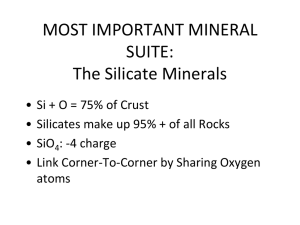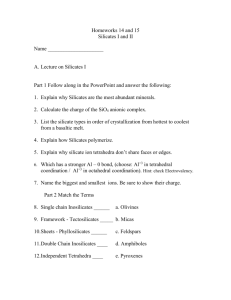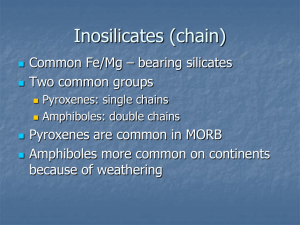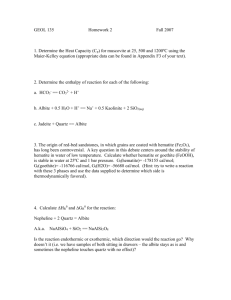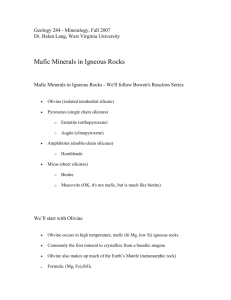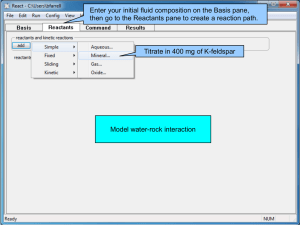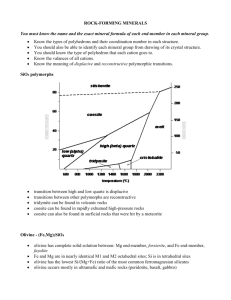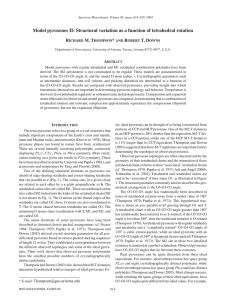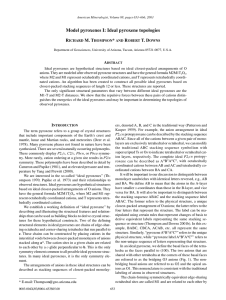Lecture 17 Silicates II mod 15
advertisement
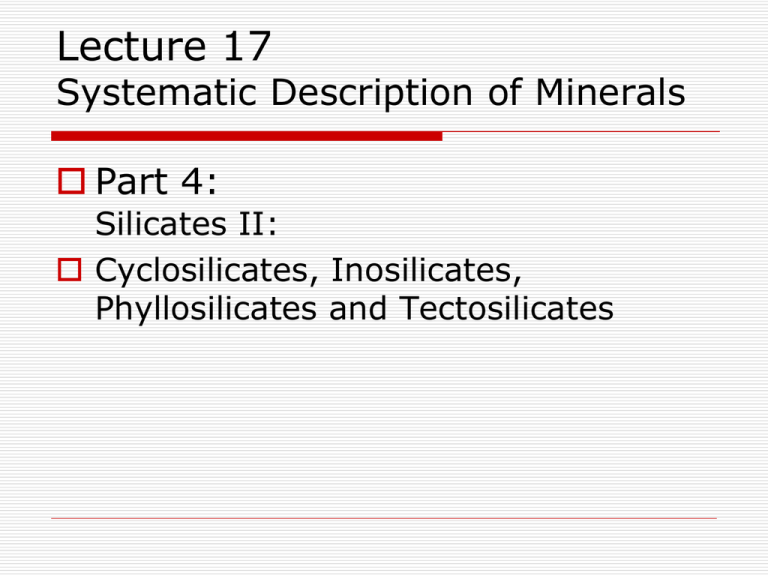
Lecture 17 Systematic Description of Minerals Part 4: Silicates II: Cyclosilicates, Inosilicates, Phyllosilicates and Tectosilicates Silicate Mineral Classification (based on arrangement of SiO4 tetrahedra) Cyclosilicates (Rings) x(SiO3) Unit Composition Hexagonal and Orthorhombic (pseudohexagonal) symmetries Forms silicate minerals with: Moderate density(2.6-3.2) and hardness (7-8) Prismatic habits Poor cleavage Beryl Beryl Common Cyclosilicates Beryl Be3Al2(Si6O18) Common accessory mineral in granite pegmatite Gem varieties – Aquamarine, Emerald, Rose Beryl, Golden Beryl Cordierite (Mg,Fe)2Al4Si5O18·nH20 Common mineral in contact metamorphosed argillaceous rocks Resembles quartz in appearance and hardness (77.5) Tourmaline Hexagonal, pleochroic, parallel extinction. Na,Ca)(Li,Mg,Al)3(Al,Fe,Mn)6(BO3)3(Si6O18)(OH)4 ( Common accessory mineral in granite pegmatite Characteristic striated prisms with trigonal outline watermelon tourmaline Inosilicates (Chain) XY(Si2O6) in Pyroxenes, WX2Y5Si8O22(OH,F)2 in Amphiboles Single and double silicon tetrahedra chains respectively Typically monoclinic and orthorhombic symmetry Single chains (Pyroxenes) develop ~90° cleavage Double chains (Amphiboles) develop 120 ° cleavage Pyroxene Structure Amphibole Structure O-coordination and Bond Strength of Other Common Cations in Silicate Minerals Electostatic Valence w/ O-2 big medium small 1/8 - 1/12 Weak 1/6 - 1/8 1/3 – 1/4 2/6 = 1/3 2/6 = 1/3 2/6 = 1/3 3/6 = 1/2 4/6 = 2/3 3/6 = 1/2 3/4 4/4 = 1 Strong Pyroxenes (XYZ2O6 ) X (M2) – Na+, Ca++, Mn++, Fe+2, Mg++, Li+ [8] Cubic Y (M1) – Mn++, Fe+2, Mg++, Fe+3, Cr+3 , Ti+4 [6] Octahedral , Z (Tetrahedral site) - Al+3 Si+4 [4] Single Si2O6 chains (the tetrahedral sites) that run parallel to the c-axis Monoclinic Pyroxenes (Clinopyroxenes - Cpx) The Diopside- Hedenbergite series - Diopside (CaMgSi2O6) - Ferrohedenbergite (CaFeSi2O6) There is complete Mg-Fe solid solution between Diopside and (Ferro)Hedenbergite Augite - (Ca,Na)(Mg,Fe,Al)(Si,Al)2O6 is closely related to the Diopside Hedenbergite series with addition of Al and minor Na substitution There is also a complete Mg-Fe substitution and small amounts of Ca substitution into the Orthopyroxene solid solution series. Old name Hypersthene Pigeonite is a high Temperature clinopyroxene Orthorhombic Pyroxenes (Orthopyroxenes - Opx) These consist of a range of compositions between Enstatite - MgSiO3 and Ferrosilite - FeSiO3 Pigeonite (Ca,Mg,Fe)(Mg,Fe)Si2O6 Augite (Ca,Na)(Mg,Fe,Al)(Si,Al)2O6 Solid immiscibility Pigeonite crystallizes in the monoclinic system, as does Augite, and a miscibility gap exists between the two minerals. Cpx Opx At lower temperatures, Pigeonite is unstable relative to Augite plus Orthopyroxene. Pigeonite => Augite + Opx Pigeonite is only found in hot volcanic and shallow intrusive igneous rocks, or as exsolution lamellae Exsolution in Pyroxene Common Pyroxene Species Diopside (Cpx) Augite (Cpx) Enstatite (Opx) Look at these two drawings. Is M1 = larger or smaller than M2? Recall X (M2) – Na+, Ca++, Mn++, Fe+2, Mg++, Li+ [8] Cubic Y (M1) – Mn++, Fe+2, Mg++, Fe+3, Cr+3 , Ti+4 [6] Octahedral Cleavage in Pyroxenes Look at this drawing. What axis are we looking down? Cleavage in Pyroxenes Amphiboles (A0-1X2Y5Z8O22 (OH,F)) A-site – Na+, K+ loose coordination 10-12 Oxygens X (M4) – Na+, Ca++, Mn++, Fe+2, Mg++, Li+ 8-fold Y (M1-3) – Mn++, Fe+2, Mg++, Fe+3, Cr+3 , Ti+4 6-fold octohedral Z (Tetrahedral T-site) - Al+3, Si+4 double-chain backbone Common Types of Amphiboles Double chains in Amphiboles TOT stacks separated by big Na+ and K+ “A” cations TOT – A assemblies staggered Cleavage ~120 – 60o Distinguishing Amphiboles with the Petrographic Microscope Inosilicates - Pyroxenoids • Wollastonite CaSiO3 is a common pyroxenoid pyroxenoid. Note pattern: Up up down up up down Wollastonite CaSiO3: Connection of silicate chains through [CaO6] octahedra in direction of [100] and [001], repeats every third tetr. Rhodonite MnSiO3 repeats structure every fifth tetrahedron Is Wollastonite stable at the surface? • CaSiO3(s) + CO2 (g) => CaCO3(s) + SiO2 (s) DGf -370.313 - 94.257 => -269.908 -204.65 Kcal/gfw Reactants Products DGrxn = S DGproducts – S DGreactants Kcal/gfw DGrxn = -474.554 + 464.57 DGrxn = -9.984 Kcal/gfw negative, so the reaction will go to the right, as written. Wollastonite will break down if exposed to CO2 at STP. Data source: Robie and Waldbaum (1968) Thermodynamic Properties of Minerals…. Pyroxenoids: Wollastonite and Rhodonite Wollastonite Rhodonite Phyllosilicate Structures Alternating Tetrahedral and Octahedral layers bound by large cations or weak electrostatic bonds Common Phyllosilicates Kaolinite Chrysotile Antigorite Talc Pyrophyllite Muscovite Biotite Lepidolite Chlorite Prehnite Alternating Tetrahedral and Octahedral layers bound by large cations or weak Van Der Waals bonds Infinite sheets of silicon tetrahedra Charge balancing metals in [6] (octahedral) Strong single cleavage parallel to silicon sheets Pyrophyllite (clay) Muscovite (mica) Mica Structures KAl2(AlSi3O10)(F,OH)2 Alternating Si Tetrahedral and Octahedral layers (TOTs)bound by large cations Phlogopite is the Magnesium end-member of the Biotite solid solution series, with the chemical formula KMg3AlSi3O10(F,OH)2. Tectosilicates (Framework) 3-D framework of linked silicon tetrahedra Variable physical properties and symmetries depending on linkage of framework groupings SiO2 Group Quartz SiO2 Feldspar Group Microcline XAl(Al,Si)3O8 Most abundant minerals, by mass or volume, in the crust Notice that Albite is an end member of both the Plagioclase and K-Spar (Alkali Feldspar) groups Compositions for Feldspars are commonly described in terms of mole percents of the end member components (e.g. Or85Ab15, An54Ab39) Anorthite Feldspars are Tectosilicates with every oxygen atom shared by adjacent silicon or aluminum tetrahedra. The tetrahedra are arranged in four-member rings that are stacked to form “crankshafts” parallel to the aaxis of the monoclinic or triclinic structure. The crankshafts are joined together in an open structure with large voids to hold the alkali metals K+ or Na+, or the alkaline earth ion Ca++ . Alkali Feldspars At low temperatures solid solution (ss) is unstable, ss exsolves to Albite + Microcline. We say the two phases are immiscible Triclinic K-spar “Microcline” Sanidine Albite Perthite (albite exsolution in microcline) High Sanidine is fully disordered with a statistically random Al-Si distribution: each tetrahedron has, on averaging over a reasonable volume, 0.25 Al atoms and 0.75 Si atoms. The Al+3 can be anywhere. Low Sanidine and Orthoclase are more ordered. For these minerals to be monoclinic, the center of symmetry in each ring must be preserved. Looking down the a-axis At still lower temperatures, the Al+3 will be completely ordered: always on the two t1 tetrahedra. This ordering will destroy the center of symmetry and the mineral will become triclinic Microcline. “TOT” Close O= Attracted to K+ K-spars diagonal b -c Looking down c-axis Plagioclase Feldspars Albite Twinning Compositional Zoning (Oscillatory) Plagioclase Composition from Albite Twins Albite twins in Plagioclase reveal solid solution composition. Feldspathoids (Si-poor) We will see Alkaline plugs on the Petrology field trips next semester Common in Alkaline (Si-undersaturated) igneous rocks Leucite – KAlSiO4 Nepheline – (Na,K)AlSiO4 Sodalite – Na8(AlSiO4)6Cl2 Scapolite Hydrous Tectosilicates Analcime (Scapolite Gp) NaAlSi2O6·H2O Natrolite (Zeolite Gp) Na2Al2Si3O10·2H2O Heulandite (Zeolite Gp) CaAl2Si7O18·6H2O Stilbite (Zeolite Gp) NaCa2Al5Si13O36·14H2O
